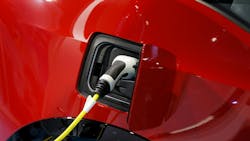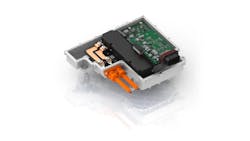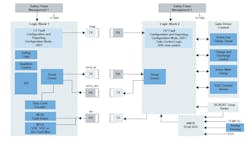Isolated Gate-Driver ICs Handle Higher Voltage Levels in EVs
NXP Semiconductors is supplying a family of isolated gate-driver ICs to control the silicon-carbide (SiC) power switches at the heart of ZF Friedrichshafen’s next-gen electric-vehicle (EV) traction inverters, which are designed up to 800 V.
While silicon still runs the show in power electronics, SiC raises the bar for the power MOSFETs at the heart of the traction inverters, which translate power from high-voltage battery packs to the EV motor. But driving these power devices efficiently, reliably, and safely is even more of a challenge than it is with silicon. High-voltage isolated gate drivers such as NXP’s GD316x are designed to bring the best out of SiC power devices.
As the auto industry races into the EV era, gate drivers are becoming a big battleground in the chip market. More accurate driving of the SiC power MOSFETs in a traction inverter can limit excess power losses in the EV and, in turn, extend its driving range per charge. ZF said its innovations in motor control and power devices along with NXP's gate drivers are driving up the power density and efficiency of its EV traction inverters.
Robert Li, SVP and GM of driver and energy systems at NXP, said that traction inverters based on NXP’s gate drivers are already on the road. NXP is also working with ZF on next-gen power electronics for EVs.
The Gate Driver: Driving the Future of the EV
Traction inverters are one of the main components of the EV’s powertrains, since they translate DC voltage from battery packs that are upgrading to 800 V into a time-varying AC voltage that controls the EV’s motor.
The traction inverter is assembled out of several “phases” of power switches primarily based on silicon and then placed in parallel with each other to share the current load. Though it’s more costly than the IGBTs and MOSFETs that have dominated the power landscape for decades, SiC is gaining ground as it brings faster switching speeds, lower conduction losses, and better thermal properties to power MOSFETs than silicon.
At the front of every IGBT and MOSFET is a gate that plays the part of a capacitor. It must be fully charged to turn “on” the power transistor, allowing for the flow of current between the drain and the source. In contrast, depleting the gate charge switches the power device “off.” The gate driver placed ahead of the FET needs to supply enough current to the gate to control turn-on and turn-off times of the device during the switching cycle. It must also apply the minimum or “threshold” voltage so that the gate can be charged in the first place.
A gate driver acts as the interface between the MCU that outputs pulse-width-modulation (PWM) signals to control the operation of the traction inverter or other system, and the IGBTs or MOSFETs that sit inside it.
Despite the faster switching speeds and other unique power-handling properties of SiC, there are several tradeoffs. For instance, driving power transistors based on SiC is a more complicated process than usual.
Although fast switching is vital for reducing switching losses, the traction inverter or other system is inevitably subject to larger transient voltages (dv/dt) or currents (di/dt) during a switching cycle. These may result in parasitics (resistance, inductance, and capacitance) that can prevent you from tapping the power of SiC MOSFETs.
Such parasitics not only impair the power efficiency of the device, but they can also give rise to sudden large voltages, otherwise known as overshoot. It could permanently damage the power IC and threaten the reliability of the system in the long term. The dv/dt, which is the changing rate of the drain-to-source voltage of the power FET during switching, can add electromagnetic interference (EMI) and other noise, too, causing ringing in the system. This can complicate the control of the SiC power FETs.
Given all of the difficulties that rear their heads at high frequencies, high temperatures, and high voltages, gate drivers typically must be designed from the ground up to work with SiC power MOSFETs, said NXP.
NXP and rivals such as Texas Instruments and Infineon Technologies are racing to roll out a new class of gate drivers that can drive SiC MOSFETs more carefully, giving you “clean” switching without unnecessary EMI. These parts are vital to reducing power losses in traction inverters that output up to tens of thousands of watts, which is raising the requirements for gate power as well. Gate drivers also protect power FETs from harm, so they’re bringing more galvanic isolation and robust protection features into the fold.
Gate-Driver ICs Engineered for the Era of EVs
NXP said that its isolated high-voltage gate drivers check all the boxes for ZF’s traction inverters targeted at EVs.
The GD316x adds a wide range of advanced control, diagnostic, monitoring, and protection features that are fine-tuned for SiC power devices and programmable over a SPI bus. The integration enables a smaller footprint while simplifying the system’s design. The gate driver adds a common-mode transient immunity (CMTI) of 100 V/ns to prevent EMI from impacting the system, along with 5 kV RMS of galvanic isolation.
One of the gate drivers in NXP’s family, the GD3160, pumps out a peak current of 15 A so that it can overcome the input capacitance of the power device and switch it on and off fast. Such a split-output gate driver gives you the ability to separate the turn-on and turn-off path of the power FET, making it possible to more tightly control the dead time between turn-off and turn-on of the transistor. It helps curb switching losses that can create unnecessary heat, which could further drag on the system’s efficiency, while limiting EMI noise.
The gate driver can deliver with a minimum voltage of −12 V and a maximum voltage of 25 V to make sure the SiC power devices are safely and firmly turned on and turned off. Most power MOSFETs based on SiC are turned on at higher voltages than silicon, ranging from about 15 to 20 V, to limit the on-resistance (RDS(on)). But, in general, these chips are turned off with negative voltages to negate EMI and enhance reliability and safety.
While SiC power MOSFETs have very small RDS(on), NXP said its family of gate drivers have a minimal amount of RDS(on) themselves to enable higher current delivery and faster switching.
Generally, IGBTs are more robust against short circuits and other sudden inrushes of current than SiC power MOSFETs. NXP said the gate driver monitors the drain and source of the power device and triggers a “soft shutdown” in the event of a short circuit or other fault current before it can permanently damage the power FET. Fast short-circuit protection times of less than 1 µs coupled with programmable gate-drive schemes help dial in the performance of the SiC power modules in ZF’s traction inverters, according to the company.
It also integrates temperature sensing to help head off overheating in the high-voltage SiC power FETs.
About the Author
James Morra
Senior Editor
James Morra is the senior editor for Electronic Design, covering the semiconductor industry and new technology trends, with a focus on power electronics and power management. He also reports on the business behind electrical engineering, including the electronics supply chain. He joined Electronic Design in 2015 and is based in Chicago, Illinois.



